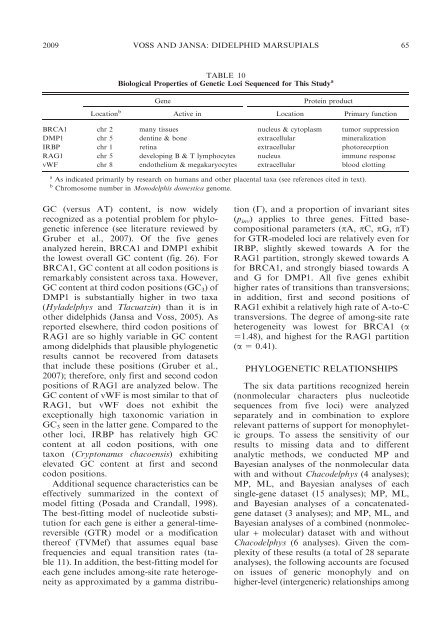phylogenetic relationships and classification of didelphid marsupials ...
phylogenetic relationships and classification of didelphid marsupials ...
phylogenetic relationships and classification of didelphid marsupials ...
You also want an ePaper? Increase the reach of your titles
YUMPU automatically turns print PDFs into web optimized ePapers that Google loves.
2009 VOSS AND JANSA: DIDELPHID MARSUPIALS 65<br />
Location b<br />
TABLE 10<br />
Biological Properties <strong>of</strong> Genetic Loci Sequenced for This Study a<br />
GC (versus AT) content, is now widely<br />
recognized as a potential problem for <strong>phylogenetic</strong><br />
inference (see literature reviewed by<br />
Gruber et al., 2007). Of the five genes<br />
analyzed herein, BRCA1 <strong>and</strong> DMP1 exhibit<br />
the lowest overall GC content (fig. 26). For<br />
BRCA1, GC content at all codon positions is<br />
remarkably consistent across taxa. However,<br />
GC content at third codon positions (GC 3)<strong>of</strong><br />
DMP1 is substantially higher in two taxa<br />
(Hyladelphys <strong>and</strong> Tlacuatzin) than it is in<br />
other <strong>didelphid</strong>s (Jansa <strong>and</strong> Voss, 2005). As<br />
reported elsewhere, third codon positions <strong>of</strong><br />
RAG1 are so highly variable in GC content<br />
among <strong>didelphid</strong>s that plausible <strong>phylogenetic</strong><br />
results cannot be recovered from datasets<br />
that include these positions (Gruber et al.,<br />
2007); therefore, only first <strong>and</strong> second codon<br />
positions <strong>of</strong> RAG1 are analyzed below. The<br />
GC content <strong>of</strong> vWF is most similar to that <strong>of</strong><br />
RAG1, but vWF does not exhibit the<br />
exceptionally high taxonomic variation in<br />
GC 3 seen in the latter gene. Compared to the<br />
other loci, IRBP has relatively high GC<br />
content at all codon positions, with one<br />
taxon (Cryptonanus chacoensis) exhibiting<br />
elevated GC content at first <strong>and</strong> second<br />
codon positions.<br />
Additional sequence characteristics can be<br />
effectively summarized in the context <strong>of</strong><br />
model fitting (Posada <strong>and</strong> Cr<strong>and</strong>all, 1998).<br />
The best-fitting model <strong>of</strong> nucleotide substitution<br />
for each gene is either a general-timereversible<br />
(GTR) model or a modification<br />
there<strong>of</strong> (TVMef) that assumes equal base<br />
frequencies <strong>and</strong> equal transition rates (table<br />
11). In addition, the best-fitting model for<br />
each gene includes among-site rate heterogeneity<br />
as approximated by a gamma distribu-<br />
Gene Protein product<br />
Active in Location Primary function<br />
BRCA1 chr 2 many tissues nucleus & cytoplasm tumor suppression<br />
DMP1 chr 5 dentine & bone extracellular mineralization<br />
IRBP chr 1 retina extracellular photoreception<br />
RAG1 chr 5 developing B & T lymphocytes nucleus immune response<br />
vWF chr 8 endothelium & megakaryocytes extracellular blood clotting<br />
a As indicated primarily by research on humans <strong>and</strong> other placental taxa (see references cited in text).<br />
b Chromosome number in Monodelphis domestica genome.<br />
tion (C), <strong>and</strong> a proportion <strong>of</strong> invariant sites<br />
(p inv) applies to three genes. Fitted basecompositional<br />
parameters (pA, pC, pG, pT)<br />
for GTR-modeled loci are relatively even for<br />
IRBP, slightly skewed towards A for the<br />
RAG1 partition, strongly skewed towards A<br />
for BRCA1, <strong>and</strong> strongly biased towards A<br />
<strong>and</strong> G for DMP1. All five genes exhibit<br />
higher rates <strong>of</strong> transitions than transversions;<br />
in addition, first <strong>and</strong> second positions <strong>of</strong><br />
RAG1 exhibit a relatively high rate <strong>of</strong> A-to-C<br />
transversions. The degree <strong>of</strong> among-site rate<br />
heterogeneity was lowest for BRCA1 (a<br />
51.48), <strong>and</strong> highest for the RAG1 partition<br />
(a 5 0.41).<br />
PHYLOGENETIC RELATIONSHIPS<br />
The six data partitions recognized herein<br />
(nonmolecular characters plus nucleotide<br />
sequences from five loci) were analyzed<br />
separately <strong>and</strong> in combination to explore<br />
relevant patterns <strong>of</strong> support for monophyletic<br />
groups. To assess the sensitivity <strong>of</strong> our<br />
results to missing data <strong>and</strong> to different<br />
analytic methods, we conducted MP <strong>and</strong><br />
Bayesian analyses <strong>of</strong> the nonmolecular data<br />
with <strong>and</strong> without Chacodelphys (4 analyses);<br />
MP, ML, <strong>and</strong> Bayesian analyses <strong>of</strong> each<br />
single-gene dataset (15 analyses); MP, ML,<br />
<strong>and</strong> Bayesian analyses <strong>of</strong> a concatenatedgene<br />
dataset (3 analyses); <strong>and</strong> MP, ML, <strong>and</strong><br />
Bayesian analyses <strong>of</strong> a combined (nonmolecular<br />
+ molecular) dataset with <strong>and</strong> without<br />
Chacodelphys (6 analyses). Given the complexity<br />
<strong>of</strong> these results (a total <strong>of</strong> 28 separate<br />
analyses), the following accounts are focused<br />
on issues <strong>of</strong> generic monophyly <strong>and</strong> on<br />
higher-level (intergeneric) <strong>relationships</strong> among

















